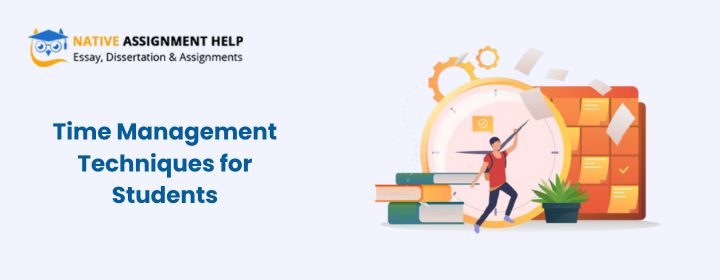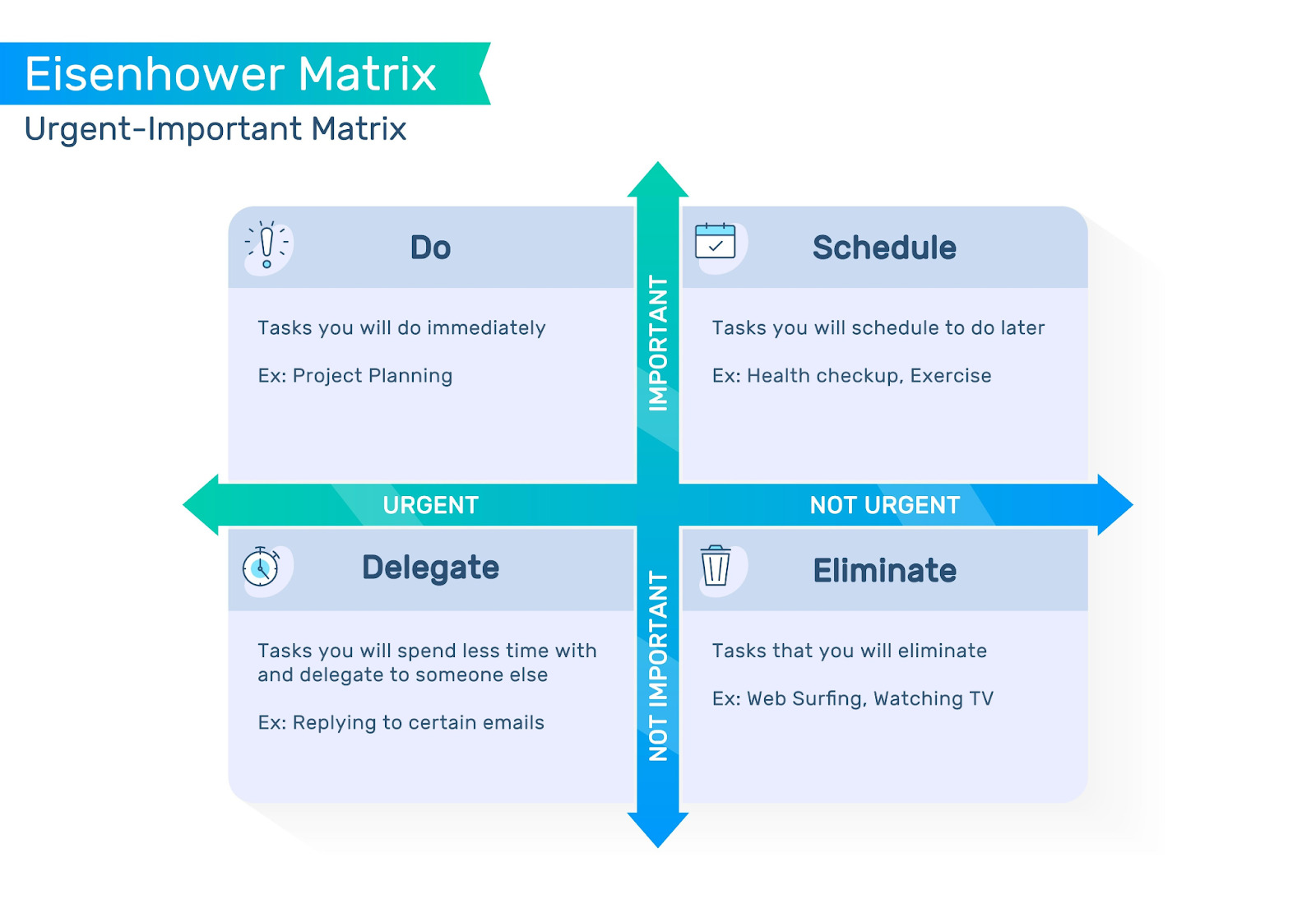
Conquering Chaos: The Ultimate Guide to Student Time Management
Everyone has the same number of hours in a day, but why are some students more productive, while others struggle to complete even regular tasks? The point is not about time; here, it is about management. The better you manage, the more you grow. Each task will be easier and completed efficiently if students learn some basic strategies and techniques to schedule their day. In this blog, we’ll guide you through some famous time management techniques, like:
- The Eisenhower Matrix,
- The Pomodoro Technique
- Eat the Frog
- Time Blocking
Let's start with a brief understanding of time management.
Why do students need to implement time management techniques?
The reality is that students today are more pressured than ever. With tough coursework and assignments, a Part-time job has become necessary for basic survival, and endless digital distractions. The result? Overload. Due to this, many students live in a cycle of procrastination, panic, and recovery without feeling fully in control.
For students, time management isn’t just about fitting more study hours. It is about survival. Without a strategy, academic stress builds, they struggle to handle deadlines, and their personal life gets completely neglected in the rush. Poor time management can snowball into missed opportunities that can lower grades and even cause serious health problems from lack of sleep and constant anxiety.
Mastering time management is essential, and even better if students start practising from a younger age, it will give them a sense of thriving rather than just surviving.
The Myths Students Believe About Time Management
One of the biggest myths of time management is multitasking, but in reality, multitasking doesn’t save any time. Science shows that continuous switching between tasks reduces focus, increases mistakes, and drains your brain faster than steady, single-tasked efforts.
Another myth is the belief that working longer hours means better work, but in reality, studying continuously without any breaks can lead to burnout, poor memory retention, and wasted effort. In reality, shorter, focused sessions are far more effective.
A third myth is “I work best under pressure.” Last-minute deadlines may feel motivating, but it is also risky; they mainly pressurise students and lead to stress, less sleep, and lower-quality work. To students, it may seem productive, but it's nothing more than survival mode.
Finally, there’s a myth that a to-do list alone is enough, but overestimating a single thing can’t make everything perfect. A task list can help, but only when it is approached by systematic prioritisation and scheduling. Otherwise, they just turn into pressure-filled reminders or unfinished work.
These myths develop false confidence, and that results in students feeling busy but not productive. Then each task, assignment, or ‘I’ll do it later” thoughts just increase the cognitive load. It's simple to understand that the heavier the load, the harder it becomes to focus and give the best performance.
Why Every Student Needs a Scheduling System
Time management doesn’t happen by accident. To stay in control, one needs a scheduling system that tracks tasks, plans study sessions, and saves valuable time. Without this, a person will just react to problems instead of resolving or controlling them. Trust me or not, a well-structured schedule is just like an assistant; it reminds you of deadlines, saves time, avoids stress, and lets you complete your academic tasks on time. Just creating a to-do list can stress students, but turning tasks into appropriate time slots makes it very easy to complete.
- Protect your personal time: many students skip rest, exercise or relaxation, but compromising your rest or free time means losing productivity. Good sleep and free time keep your brain sharp and reduce burnout.
- Avoid all-nighters: It may feel productive to stay awake till late, but it actually weakens focus, memory, and long-term performance. Recovery time is as important as studying time.
It's not just about the proper organisation of the daily tasks, but a scheduling system can help in balancing life, energy and lasting success.
The Time-Management Techniques Students Search For
There are hundreds of productivity techniques online, but they are unrealistic and complex to implement. What you really need are tested, easy and approachable strategies to actually work when assignments increase and syllabus needs attention. Here, our four proven techniques stand out: the Eisenhower Matrix, the Pomodoro Technique, Eat the Frog, and Time Blocking. Each of these helps simplify common student struggles, whether it’s figuring out what to tackle first, staying focused during study sessions, or finally beating procrastination.
The Eisenhower Matrix: Deciding What to Do Next
What it is: The Eisenhower Matrix is an easy and powerful way to figure out what actually needs your attention. It helps you sort tasks by urgency and importance, so you can pick the necessary one first. You can do it by imagining or creating a square split into four sections:

Figure: Eisenhower Matrix
- Urgent + Important: Top priority tasks that can’t wait. E.g., assignment submission.
- Important but Not Urgent: Important for long-term success, but doesn’t have immediate submission. E.g., revision for next week's exam.
- Urgent but Not Important: Tasks which seem urgent but don’t help you anywhere. E.g., unnecessary meetings or emails.
- Not Urgent + Not Important: These can be termed as distractions. E.g., Scrolling on social media.
How to start: First, create a list of tasks to be completed next week. Then organise each task according to priority. The visual layout instantly shows you what really matters.
Implementation for students: You must be thinking that the 1st box (Urgent + Important) should be the most prioritised, not necessarily because your focus should be on the 2nd box (Important but Not Urgent). This will help you not to suffer at the last stage, and your tasks will be completed before time.
The Pomodoro Technique: Maximizing Focus, Minimizing Burnout
What it is: The Pomodoro technique breaks your study into short, focused sessions so you feel less overwhelmed. Pick one task and work on it for 25 minutes straight without any distractions, then take a 5-minute break. After every four rounds, take a longer break of 15-30 minutes.
How to start: Pick a timer, it can be your phone (try not to use phones), a study app, or even a kitchen timer. Choose one task, strictly avoid multitasking and start working or studying for a full 25 minutes.
Implementation for students: Pomodoro sessions are highly recommended for studying, writing drafts, or revising. Do not underestimate the breaks; those pauses refresh your brain, making it easier for your brain to stay focused longer. Note: Do not use your phone, social media or TV during breaks, avoid screens. The method will help you avoid burnout and provide you with efficient learning.
Eat the Frog: Beating Procrastination Early
What it is: Eat the Frog means completing the hardest task first in the morning. The frog is usually the task which is procrastinated due to difficulty or less favourability. You think of completing the task, but feel overwhelmed when you start.
How to start: Think each evening about what your frog is for the next day. That can be a tough essay, solving difficult problems or preparing a presentation.
Implementation for students: Marking the frog first in the morning helps you gain momentum in the sense that an early win makes the rest of the tasks feel easier and smaller. At first, you were carrying the weight of the task the whole day, and when you think of working on it feels so difficult that you end up dropping it. Now, completing it at the beginning will lighten your mind and improve efficiency throughout the day.
Time Blocking: Turning Your Day into a Roadmap
What it is: Unlike to-do lists, time blocking assigns each task to a specific time slot, which eliminates the stress of deciding when to work in the moment. Like, instead of writing, “study for biology”, you can write “5-6 PM: revise biology.
How to start: You can plan on paper, use a digital calendar, or use any task reminder app. Divide your day into categorised blocks for classes, meals, and rest. Always keep it flexible for unexpected delays.
Implementation for students: Think of your time blocks as actual appointments. Do not let yourself skip any tasks, and turn off your notifications so people may know you’re busy. Keep your morning hours reserved for heavy tasks and use lighter times for chores and reviews. Time blocking takes the stress of constantly deciding what to do next. Note: If you can’t follow a strict routine, then keep it a little flexible, like in the morning you have to complete three tasks within a decided time.
The Anti-Productivity Guide of Time Management: What NOT to Do
Even the best strategies fail if you fall for silly mistakes:
Mistake 1: The Endless To-Do List
Students often just add tasks to the list but don’t rank them according to priority. That creates stress and wastes a lot of time in scheduling.
Mistake 2: Ignoring Your Energy Levels
If you try to work on tough tasks in the evening, you’ll end up frustrated with poor performance. So take your time to understand your energy levels and assign the tasks according to them.
Mistake 3: The Pitfall of Perfect Planning
Sometimes students get stuck in creating a perfect schedule, and that we call falling into the trap of perfection. You just need to create an actionable, practical schedule because it will be updated daily.
Your Integrated Scheduling Plan: Combining the Best Methods
You can’t rely on the single method completely; that's why we recommend you combine all of them and watch the magic happen.
A Synergistic Approach: Using All Three Methods Together
- Use Eisenhower to decide what matters.
- Use Eat the Frog to start strong.
- Use Pomodoro to stay focused.
- Use Time Blocking to make it all fit in your schedule.
At first, you may have to plan manually or make some efforts, but over time your mind will automatically define what is important, when to do and how to do without wasting a second. So the process is not that hard; it’s just a practice to approach for a successful and stress-free life.
How to Include All Together in 6 Simple Steps
- List your tasks for the week: Mention all the tasks for the next week, such as readings, revisions, projects even chores. It will reduce mental clutter and give a clear picture.
- Sort with the Eisenhower Matrix: Now organise the list into four boxes. This will help you to prioritise your focus at the right place.
- Choose your frog: Analyse your list and find the one task that is hard and will be delayed. That's your frog, plan to do it first thing in the morning so it doesn’t hang you the whole day.
- Block your time: Now turn your day into a roadmap by assigning each time slot. Don’t forget to block breaks, meals, and free time. Treat those time blocks as appointments.
- Work in Pomodoros: When you decide to work, set a timer for 25 minutes and, without any distractions, work on it. Then give yourself 5-minute breaks, after 4 rounds take a 25-minute rest.
- Review daily: At the end of the day, check your wins and losses. Celebrate the wins (even small ones), don’t regret losses, just shift them to tomorrow’s plan. These few minutes will help you get better the next day.
Conclusion: Take Control Before Chaos Takes Control of You
You don’t need to stress about getting perfect; mastering time management is just about building simple systems into practice that keep you in control. With techniques like the Eisenhower Matrix, Pomodoro, Eat the Frog, and Time Blocking, students can turn their lives from chaos to clarity. You just have to start small, stay consistent and watch how your daily discipline turns into long-term success both academically and personally. Reminder: The rules of techniques can be used according to your life; you don’t need to create a perfect schedule, maintain a flexible idea of time management methods and flow it freely.
If you’re late in implementing time management techniques, and want your assignment to be completed on time. Don’t worry, at Native Assignment Help, we assist every student with high-quality assignments. Review our dashboard for more details.



